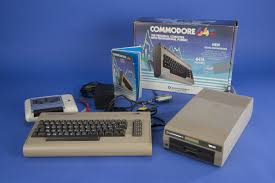
The Original Commodore Computer: A Revolutionary Piece of Tech History
When it comes to the history of personal computing, the original Commodore computer holds a special place. Released in the early 1980s, the Commodore computer was a game-changer that brought computing power into homes and businesses across the world.
The original Commodore computer, known for its iconic design and innovative features, paved the way for future generations of computers. With its affordability and user-friendly interface, it quickly became a popular choice among consumers looking to explore the world of computing.
One of the most notable features of the original Commodore computer was its built-in keyboard, which made it easy for users to interact with the machine. Additionally, its compatibility with a wide range of software applications and games made it a versatile tool for both work and play.
Over the years, the original Commodore computer has become a collector’s item, sought after by enthusiasts who appreciate its historical significance and groundbreaking technology. Its legacy lives on in modern computing devices, which owe much to the innovations introduced by Commodore.
As we look back on the impact of the original Commodore computer, we can appreciate how it revolutionized the way we interact with technology and set the stage for future advancements in computing. Its influence can still be felt today, reminding us of the enduring legacy of this pioneering piece of tech history.
Frequently Asked Questions About Original Commodore Computers
- What was the first Commodore computer?
- Do Commodore computers still exist?
- What was the original Commodore computers?
- How much is an original Commodore 64 computer?
- What computer did Commodore use in 1980?
- Are old Commodore computers worth anything?
- How much did the Commodore 64 cost in 1985?
What was the first Commodore computer?
The first Commodore computer was the Commodore PET (Personal Electronic Transactor), introduced in 1977. Designed by Chuck Peddle, the PET was a landmark product that marked Commodore’s entry into the personal computing market. With its all-in-one design featuring a built-in monitor and keyboard, the PET was a pioneering machine that set the stage for Commodore’s future success in the computer industry. Its release laid the foundation for a series of iconic computers that would follow, shaping the course of computing history.
Do Commodore computers still exist?
Yes, Commodore computers still exist today, although they are considered vintage or retro technology. Enthusiasts and collectors around the world continue to maintain and preserve original Commodore computers, ensuring that these iconic machines remain a part of computing history. While they may not be in widespread use for everyday tasks, the nostalgia and historical significance of Commodore computers have kept them alive in the hearts of fans and tech enthusiasts. Whether displayed in museums, showcased at retro computing events, or lovingly restored by dedicated individuals, Commodore computers continue to hold a special place in the world of computing.
What was the original Commodore computers?
The original Commodore computer refers to the Commodore PET (Personal Electronic Transactor), which was released in 1977. The PET was one of the earliest personal computers on the market and featured a built-in cassette tape drive for storage, a monochrome monitor, and a full-size keyboard. It was aimed at both home users and businesses, offering a compact design and user-friendly interface. The PET laid the foundation for Commodore’s future success in the computer industry and remains an iconic piece of tech history.
How much is an original Commodore 64 computer?
The value of an original Commodore 64 computer can vary depending on its condition, included accessories, and market demand. Generally, a fully functional and well-maintained Commodore 64 with its original peripherals and packaging can fetch a higher price among collectors and enthusiasts. On the other hand, a used or non-working unit may be more affordable for those looking to experience retro computing without breaking the bank. It’s advisable to research current market trends and consult with experts in vintage computing to determine a fair price for an original Commodore 64 computer.
What computer did Commodore use in 1980?
In 1980, Commodore used the iconic Commodore PET computer, also known as the Personal Electronic Transactor. The Commodore PET was one of the earliest personal computers produced by Commodore and played a significant role in shaping the future of computing. With its built-in monitor and keyboard, the PET was a pioneering device that offered users a complete computing experience in a single package. Its introduction in 1977 marked Commodore’s entry into the personal computer market and set the stage for the company’s subsequent success with other models like the Commodore 64.
Are old Commodore computers worth anything?
The value of old Commodore computers can vary depending on factors such as the model, condition, rarity, and market demand. Some vintage Commodore computers, especially those in good working condition or with specific rare features, can be worth a significant amount to collectors and enthusiasts. Popular models like the Commodore 64 or Amiga series tend to hold more value due to their historical significance and nostalgic appeal. It’s advisable to research current market trends and consult with experts in vintage computing to determine the potential worth of old Commodore computers before making any decisions about buying, selling, or collecting them.
How much did the Commodore 64 cost in 1985?
One of the frequently asked questions regarding the original Commodore computer is about its price in 1985. In 1985, the Commodore 64 was priced around $149 to $199, depending on the retailer and any ongoing promotions or discounts. This competitive pricing played a significant role in making the Commodore 64 one of the best-selling home computers of its time, further solidifying its popularity among consumers and contributing to its lasting legacy in the world of computing.
